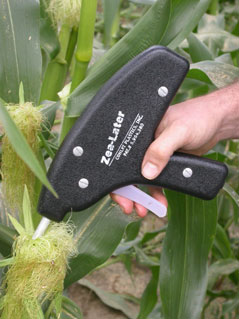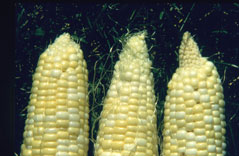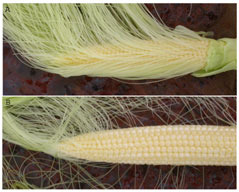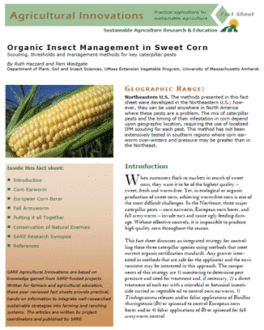
Application method: This method involves walking through the stand of corn and treating the top ear of each plant. Only one application per ear is recommended. Treat each block when most ears are close to the ideal stage. It is cost-effective to treat only one ear per stalk. If silk emergence is very uneven throughout the field, it may be necessary to go through the stand a second time to treat late-emerging silks and achieve optimal control without tip fill problems. Apply 0.5 ml per ear (equivalent to five drops from an eyedropper) directly to the silk at the tip of the ear so that it will coat the silk channel. Higher quantities do not appear to give better control and may cause slightly oily ears at harvest.
Tools: A hand-held applicator is needed to deliver oil to each ear. Oil sprays are phytotoxic and result in sticky brown husks. There is no way to avoid taking time to apply the oil to each ear. Eye droppers and converted oil cans can be made to work, but for commercial corn acreage durability, consistency, and ease of use are critical. The Zea-later™ (Photo C), a hand-held applicator designed at the University of Massachusetts and Hampshire College expressly for this purpose, is being distributed by Johnny's Selected Seeds (207-861-3902). This device is durable, comfortable to hold and use, and delivers 0.5 ml of oil with each squeeze of the trigger. Tubing connects the device with a two liter bottle for the oil that can be strapped around your waist.
Cost: The cost of this method including labor and materials is approximately $100 to $120 per acre. To treat one acre requires about eight to ten hours of labor. Typical materials include about 0.5 lb dry Bt product, two gallons of corn or soy oil, and 1.6 cups of lecithin per acre. The price may change if other materials are used.
Timing of application: Timing of application:_ Proper timing of the oil application is one of the most important factors in the successful use of this method. The best time to apply oil is when the tips of the silks have begun to wilt and turn brown, and pollination is nearly complete (Photo C). In western Massachusetts this generally happens five to seven days after silk growth starts- three to four days after the silk is fully grown, and about 14 to 21 days before harvest. Although caterpillars that are already in the ear may be killed by the Bt/oil application, the best control is achieved when it is present prior to larval entry. The Bt/oil barrier persists after application and continues to kill newly entering larvae [2].
Within a field, plants grow at different rates and begin silking at different times. In a relatively even stand, silk emergence is concentrated in a three- to four-day period. To determine the best time for oil applications, note the day on which 50% of the corn has begun to show silk, and count from that date.

Applications made earlier than five days after silk do not appear to give better control and may result in a higher rate of “cone” tips (Photo D). Cone tip develops when oil interferes with pollination of the silks that are attached to the tip of the ear, which are the last silks to develop. This results in unfilled kernels in the last half-inch of the tip. While partially-filled tips are a relatively common occurrence in sweet corn, the lack of kernel growth caused by oil is more pronounced.
Oil applied later than eight to nine days after silk initiation can result in more feeding damage to the kernels caused by caterpillars that entered the ear prior to the application. There is a window between five and eight days after silk initiation that provides the best combination of corn earworm control and ear fill [3, 11].
This provides some flexibility in treating blocks of corn as they become ready. Since the development of corn varies greatly depending upon the temperature, one way to determine if the corn is ready to be treated is to carefully open some representative ears from the field. If the silks are all still attached to the kernels (PhotoE-1) then the corn is too young. The silks will be detached from the developing kernels if pollination of the kernel has taken place. If the silks are mostly detached, and connected only at the top 0.5” to 1.0” of the tip, then the ear is ready to be treated (Photo E-2).
Materials
Regulatory issues: Any material applied to your commercial sweet corn for caterpillar control must conform to two separate federal laws; three if you are organically certified.
1) The Federal Insecticide, Fungicide and Rodenticide Act (FIFRA) regulates pesticides: all materials applied as a insecticide must be registered by EPA and have a pesticide label that includes sweet corn, or it must be exempt from labeling (FIFRA, Section 25b). Note: each state has its own labeling regulations, which may be more restrictive than FIFRA; some states do not allow the exemptions. Contact your state agency in charge of pesticides for instructions on the legal use of FIFRA exempt materials in your state (see National Pesticide Information Center website for a list of state agencies in charge of pesticides).
2) The Federal Food, Drugs and Cosmetics Act (FFDCA), regulates all materials applied to food crops; accordingly, the material applied to the corn ear must have a residue tolerance or have a tolerance exemption (section 408).
3) A third federal law applies to organic farmers: the National Organic Rule. This law requires that materials used be allowed by the National Organic Program or the Organic Materials Review Institute.
The materials discussed below satisfy all of these criteria.
Other Other insecticides may be appropriate and effective; however, we have not tested their effectiveness nor determined the legality of applying them directly to the corn ears in this manner. If you want to try other materials, review the label and check with the manufacturer, the EPA or your state agency responsible for pesticide regulations (see Regulatory Issues, above).
Insecticides:
Bacillus thuringiensis subsp. Kurstaki. Corn earworm larvae feed on silks as they move down the silk channel, then feed on the tip of the ear. Early in ear development the silk channel is several inches long (at harvest it ranges from 0.1 to 2 inches). Oil carries Bt down the silk channel where larvae ingest a toxic dose, cease feeding, and die before reaching the ear. Bt mixed with oil is more effective than Bt in water [4].Use a microbial Bt product that is registered and labeled for use in sweet corn, and use the lowest labeled rate for corn earworm or European corn borer. In trials using Dipel DFTM it was found that using a concentration of Bt that delivers Bt at the lowest labeled rate of 0.5 lb/acre produced better control than lower rates and as good control as higher rates [5]. This translates to approximately 3 tablespoons per liter of oil, for a plant population of 16,000/acre.

If you are farming in accordance with organic certification standards, check with your certifier, the National Organic Program or the Organic Materials Review Institute to be sure that the Bt product you want to use is allowed. As of January 2005 there were no organically certified liquid Bt suspensions. For dry formulations the Bt must be dissolved in water first, and then added to the oil. To achieve a stable suspension of dissolved Bt in the oil an emulsifier can be added to the oil (see Emulsifiers, below). Because of the safety and regulatory status of Bt products and the long interval before harvest, use of Bt products in this manner is in accordance with pesticide and food safety regulations.
Neem products also can be used as the insecticide in this method. The University of Massachusetts Amherst has conducted a trial using one product (Aza-directTM), at three concentrations of neem in oil: 1:1, 1:10 and 1:20, neem:oil (volume to volume ratio). All concentrations resulted in reduced ear damage compared to oil alone and there was no significant difference between concentrations [5]. Be sure that the label of the product indicates it is appropriate for use on sweet corn.
Spinosad Recent trials have shown that spinosad works well as an insecticide in the direct silk method. EntrustTM, the organic formulation of spinosad, is currently labeled for use in sweet corn and can be legally applied to corn silks using this method. Use a rate in the range recommended on the label (1-2 oz/acre; 1 oz = 6.3 Tablespoons). Since EntrustTM is a dry formulation, suspension in oil is best achieved when used with an emulsifier (see Emulsifiers, below).
